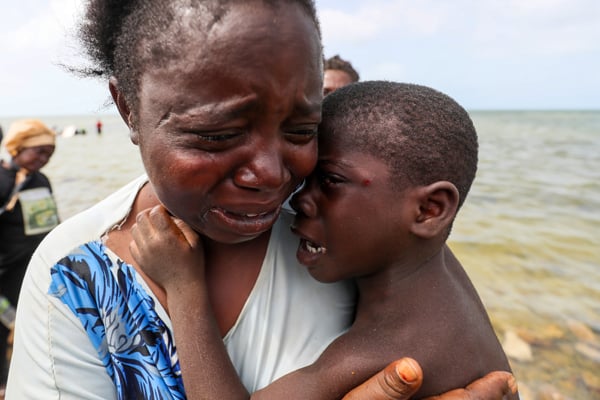Prime
Almost 800 migrants drowned off Tunisia in six months

A migrant mother from Africa, stranded on the seashore at the Libyan-Tunisian border in Ras Jedir, cries holding her son on July 26, 2023. PHOTO/ AFP
What you need to know:
- The Italian government says that more than 80,000 people have crossed the Mediterranean and arrived on its shores so far this year, mostly from Tunisia and war-scarred Libya.
- Between January 1 and June 20, a total of 34,290 migrants were intercepted and rescued, sharply up from 9,217 over the same period of last year, Jebabli said.
Almost 800 irregular migrants drowned off Tunisia in the first half of this year as they tried to reach Europe by boat, a National Guard spokesman told AFP Thursday.
"789 bodies of migrants were recovered from the sea, including 102 Tunisians, the others foreigners and unidentified people," said Houcem Eddine Jebabli, adding that more than 34,000 were rescued.
The North African country has become a major gateway for irregular migrants and asylum-seekers attempting the perilous sea voyage in often rickety boats in the hope of a better life in Europe.
The distance between Tunisia, near its second city of Sfax, and the Italian island of Lampedusa is about 130 kilometres (80 miles), and the sea voyages pick up in the summer months.
Between January 1 and June 20, a total of 34,290 migrants were intercepted and rescued, sharply up from 9,217 over the same period of last year, Jebabli said.
More than 30,000 of those rescued this year were foreigners, mostly from sub-Saharan Africa, he said.
Coastguard units carried out 1,310 operations in the first six months, more than double the number of missions for that period last year.
The Italian government says that more than 80,000 people have crossed the Mediterranean Sea to arrive on its shores so far this year, mostly from Tunisia and from war-scarred Libya.
The central Mediterranean has become the world's deadliest migratory route, claiming more than 20,000 lives since 2014, according to the International Organization for Migration.
Flaring racial tensions
As Tunisia has become a growing hub on the migrant route, racial tensions and violence have flared in the country of 12 million which is struggling with a deep economic crisis.
High inflation and growing unemployment have seen many Tunisians too try to flee their country.

Migrants from Africa, stranded on the seashore at the Libyan-Tunisian border in Ras Jedir, stay on the rocky beach on July 26, 2023. PHOTO / AFP
Xenophobic attacks have repeatedly targeted black African migrants and students, fuelled by incendiary rhetoric from autocratic President Kais Saied.
Saied -- who rules by decree since a power grab two years ago -- has alleged that "hordes" of sub-Saharan migrants were causing crime and posing a demographic threat to the mainly Arab country.
Earlier this month, as Sfax was rocked by racial violence, authorities loaded many migrants onto buses and left them stranded in remote desert areas near Algeria and Libya in searing summer heat.
Human Rights Watch said up to 1,200 black Africans were "expelled or forcibly transferred by Tunisian security forces" to the border regions with Libya and Algeria this month.
The Tunisian Red Crescent, and Libyan border guards, have reported helping migrants left without water and food in heat that has topped 40 degrees Celsius (104 Fahrenheit).

Migrants from Africa, stranded on the seashore at the Libyan-Tunisian border in Ras Jedir, react towards journalists on July 26, 2023.PHOTO / AFP
Saied sacked the Tunisian government and froze parliament in a dramatic July 2021 move against the sole democracy to emerge from the Arab Spring uprisings.
The European Union has recently been in talks with his government, offering Tunisia a major funding package to help it revive its flagging and debt-hit economy, and better secure its borders.





